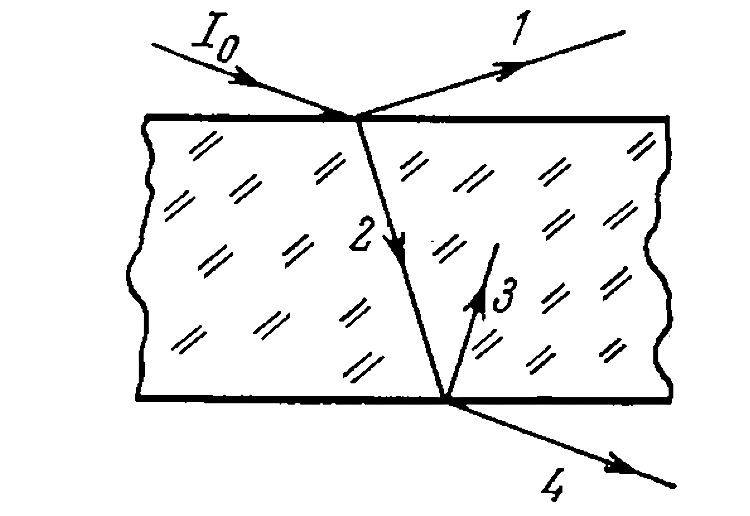A narrow beam of natural light falls on a set of N thick plane-parallel glass plates at the Brewster angle. Find:
(a) the degree P of polarization of the transmitted beam,
(b) what P is equal to when N=1,2,5, and 10.
When natural light is incident on a glass plate at Brewster's angle, the transmitted light has
I'∣∣=I0/2 and I''⊥=16n4(n2+1)4I0/2=α4I0/2
where I0 is the incident intensity
After passsing through the 2nd plate we find
I''''∣∣=12I0 and I''''∣∣=(α4)212I0
Thus after Nplates Itrans∣∣=12I0
Itrans⊥=α.4N12I0
Hence P=1−α4N1+α4N where α=2n1+n2
(b) α4=0.726 for n=32.
Thus P(N=1)=0.158,P(N=2)=0.310
P(N=5)=0.663,P(N=10)=0.922.
Topper's Solved these Questions
- OPTICSBOOK - IE IRODOV, LA SENA & SS KROTOVCHAPTER - OPTICSEXERCISE - Dispersion And Absorption Of Light
24 Videos
- OPTICSBOOK - IE IRODOV, LA SENA & SS KROTOVCHAPTER - OPTICSEXERCISE - Optics Of Moving Sources
22 Videos
- OPTICSBOOK - IE IRODOV, LA SENA & SS KROTOVCHAPTER - OPTICSEXERCISE - Diffraction Of Light
60 Videos
- MECHANICSBOOK - IE IRODOV, LA SENA & SS KROTOVCHAPTER - MECHANICSEXERCISE - Mechanics Problems
92 Videos
- OSCILLATIONS AND WAVESBOOK - IE IRODOV, LA SENA & SS KROTOVCHAPTER - OSCILLATIONS AND WAVESEXERCISE - Electromagnetic Waves, Radiation
36 Videos
Similar Questions
A narrow beam of natural light falls on the surface of a thick transparent plane-parallel plate at the Brewster angle. Its top surface. Find the degree of polarization of beams 1−4 (Fig.)

View SolutionA beam of natural light falls on the surface of glass at an angle of 45∘. Using the Fresnel equations, find the degree of polarization of
(a) reflected light,
(b) refracted light.
View SolutionNatural light falls at the Brewster angle on the surfcae of glass. Using the Fresnel equations, find
(a) the reflection coefficient,
(b) the degree of polarization of refracted light.
View SolutionA light beam falls upon a plane-parallel glass plate d=6.0cm in thickness. The angle of incidence is θ=60∘. Find the value of deflection of the beam which passed through that plate.
View SolutionA plane beam of natural light with intensity I0 falls on the surface of water at the Brewster angle. A fraction ρ=0.039 of luminous flux is reflected. Find the intensity of the refracted beam.
View SolutionA beam of natural light falls on a system or N=6 Nicolprisms whose transmission planes are turned each through an angle φ=30∘ with respect to that of the foregoing prism. What fraction of luminous flux passes through this system ?
View SolutionA ray of light falls at an angle of 30∘ onto a plane-parallel glass plate and leaves it parallel to the initial ray. The refractive index of the glass is 1.5. What is the thickness of d of the plane if the distances between the rays is 3.82cm ? [Given: sin−1(13)=19.5∘,cos19.5∘=0.94,sin10.5∘=0.18]
View SolutionTwo identical imperfect polarizers are placed in the way of a natural beam of light. When the polarizers' planes are parallel, the system transmits η=10.0 times more than in the case of crossed planes. Find the dergee of polarization of light produced
(a) by each polarizer separately,
(b) by the whole system when the planes of the polarizers are parallel.
View SolutionA beam of monochromatic light passes through a pile of N=5 identical plane-parallel glass plates each of thickness l=0.50cm. The coefficient of reflection at each surface of the plates is ρ=0.050. The ratio of the intensity of light transmitted through the pile of plates to the intensity of incident light is τ=0.55 Neglecting the secondary reflections of light, find the absorption coefficient of the given glass.
View SolutionA narrow beam of plane-polarized light passes through dextrorotatory positive compound placed into a longitudinal magnetic field as shown in Fig. Find the angle through which the polarization plane of the transmitted beam will turn if the length of the tube with the componed is equal to l, the specific rotation constant of the compound is equal to α, the verder constant is V, and the magnetic field strength is H.

View Solution
